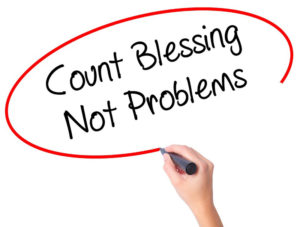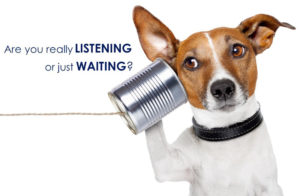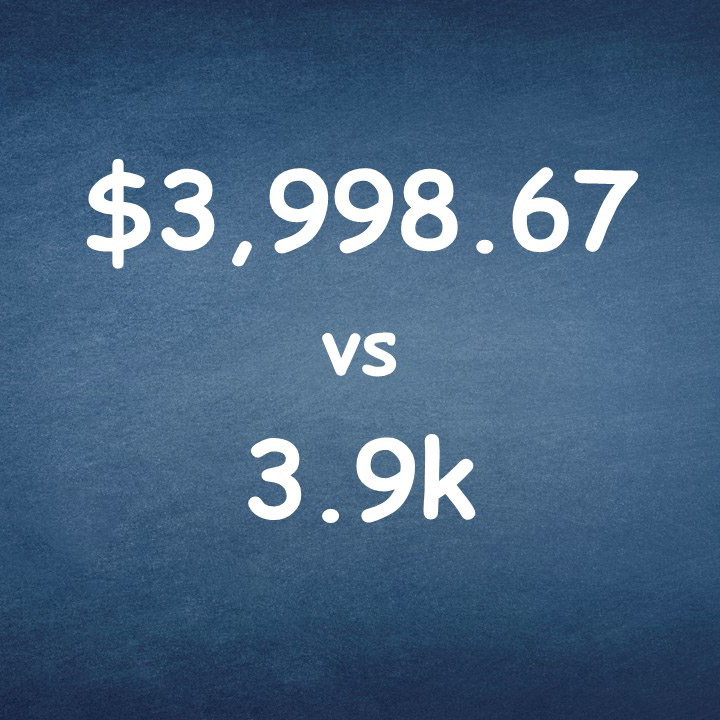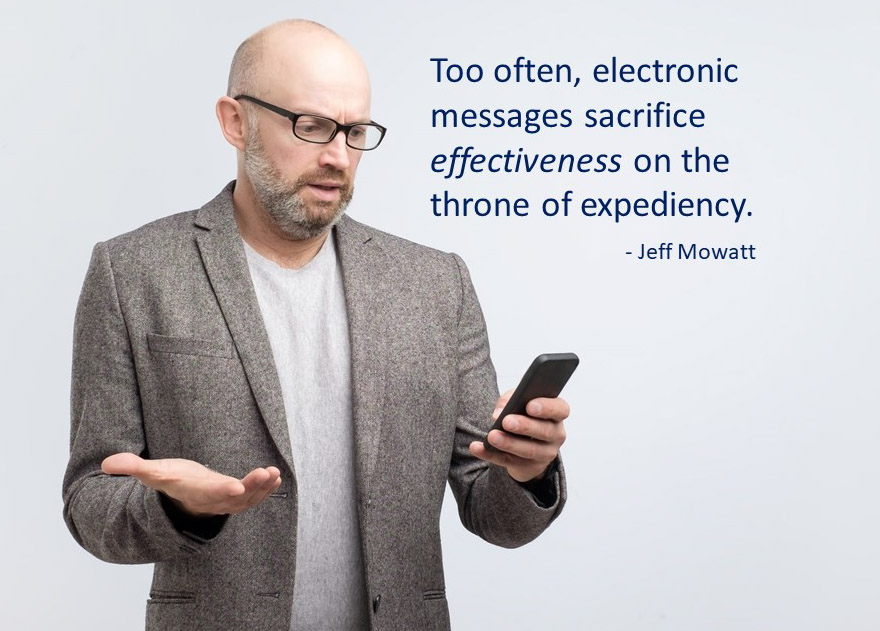Trusted Advisor Customer Service Blog Posts
Written By Jeff Mowatt – (all original content not AI generated)
Written By Jeff Mowatt – (all original content not AI generated)
Don’t be Better, be Different
Admit it – your customers can find a supplier somewhere in the world with cheaper prices than you. That means that trying to compete based on price is rarely a viable option. What likely differentiates you from others is not your prices, but your service. The logical question then becomes is your service really that different from others. Most managers think great service means their employees are nice. But your competitors know how to be nice too. What distinguishes service as being different is when you focus more on creating trust then merely trying to be nice. Who would you rather do business with – the friend who’s nice, but unreliable, or the professional who makes service commitments and then keeps them consistently? In this economy, nice is average, trust-worthy is different.
They Myth of Self Expression
 I asked my Mom and Dad, what their secret was to being happily married for over 60 years. They replied, “Knowing when to keep your thoughts to yourself.” Unfortunately, a lot of messages in today’s media are laced with sarcasm and put-downs, supposedly meant to be funny. We become so inured to this that we forget how hurtful these ‘witty’ quips can be to others. I’ve been through divorce myself (fortunately no kids at the time), and thankfully I’m now happily married with two daughters. Having been through the wars myself, I have to agree with my folks. Most often relationships – at home and at work – grow stronger when we resist the temptation to express every ‘innocent’ put-down, minor annoyance, and fleeting thought.
I asked my Mom and Dad, what their secret was to being happily married for over 60 years. They replied, “Knowing when to keep your thoughts to yourself.” Unfortunately, a lot of messages in today’s media are laced with sarcasm and put-downs, supposedly meant to be funny. We become so inured to this that we forget how hurtful these ‘witty’ quips can be to others. I’ve been through divorce myself (fortunately no kids at the time), and thankfully I’m now happily married with two daughters. Having been through the wars myself, I have to agree with my folks. Most often relationships – at home and at work – grow stronger when we resist the temptation to express every ‘innocent’ put-down, minor annoyance, and fleeting thought.
How Sharing Less creates more Trust
 If you’ve been reading my tips or attending my seminars over the years, you’ve likely heard me refer to the importance of being discreet about what you share with customers. Samples are at Six Oversharing Blunders and Keep this Between Us. Here’s the problem - one of our most persuasive tools when helping people to make buying decisions is referencing similar work you’ve done for other customers. Assuming you have your customer’s permission to use them as a reference, its fine to share general information, but rarely is it appropriate to share anything about their monetary affairs. So if you are pressed to reveal your client’s numbers, here’s a handy phrase, “For obvious reasons I don’t share my clients’ financials, just as I won’t share yours with anyone else. What I can tell you is…” It’s ironic how explaining why you’ll share less information actually creates more trust.
If you’ve been reading my tips or attending my seminars over the years, you’ve likely heard me refer to the importance of being discreet about what you share with customers. Samples are at Six Oversharing Blunders and Keep this Between Us. Here’s the problem - one of our most persuasive tools when helping people to make buying decisions is referencing similar work you’ve done for other customers. Assuming you have your customer’s permission to use them as a reference, its fine to share general information, but rarely is it appropriate to share anything about their monetary affairs. So if you are pressed to reveal your client’s numbers, here’s a handy phrase, “For obvious reasons I don’t share my clients’ financials, just as I won’t share yours with anyone else. What I can tell you is…” It’s ironic how explaining why you’ll share less information actually creates more trust.
Close the Loop and Gain a Raving Fan
 A manager in one of my seminars asked me to share an easy, low cost tip that would turn their existing customers (their office tower tenants) into raving fans. In response, I walked her and her property management team through these two scenarios; in both cases a tenant calls a property manager about a plumbing issue that has put their washroom out of service.
A manager in one of my seminars asked me to share an easy, low cost tip that would turn their existing customers (their office tower tenants) into raving fans. In response, I walked her and her property management team through these two scenarios; in both cases a tenant calls a property manager about a plumbing issue that has put their washroom out of service.
First case: The property manager books a plumber who then fixes the problem. End of story.
Second case: The property manager books a plumber. Plumber fixes problem and promptly texts property manager: repair completed. Property manager then phones the tenant advising her the washrooms are back in service. Tenant emails her coworkers: washrooms are back up and running.
Consider the difference in customer perception by merely reporting back when something is done. In the first case customers may be waiting all day; not realizing the washrooms are repaired. Second case, when the customer is informed when the works complete, they’re more likely to think, “Wow, that was fast. These folks are really on top of things!” Plus, the service provider has made the customer look like a hero to her colleagues. The service providers didn’t work harder or faster. They just reported back promptly. Takes seconds. Costs nothing. So, how are you and your team members when it comes to closing the customer communication loop?
Keeping constructive during covid
 If your business is down and your enthusiasm is waning during covid, here's a tip proven to boost revenues and put more spring in your step. Let me start by saying I've never been a fan of pseudo-science theories like "The Secret" where - by simply visualizing things you want, they begin to manifest themselves. Don't get me wrong, I'm an avid proponent and practitioner of writing goals and taking steps to accomplish them. I don't however, think putting a picture of a Maserati on your fridge is going to do a single thing to make it appear in your driveway. On the contrary, I think having a picture of a car we can't yet afford insinuates to our psyche that the aging Corolla we drive is depressing. When obstacles occur (like a freakin’ pandemic!) that sportscar staring at us from our wall becomes an accusation; a reminder of what we are lacking. What if we took the opposite approach?
If your business is down and your enthusiasm is waning during covid, here's a tip proven to boost revenues and put more spring in your step. Let me start by saying I've never been a fan of pseudo-science theories like "The Secret" where - by simply visualizing things you want, they begin to manifest themselves. Don't get me wrong, I'm an avid proponent and practitioner of writing goals and taking steps to accomplish them. I don't however, think putting a picture of a Maserati on your fridge is going to do a single thing to make it appear in your driveway. On the contrary, I think having a picture of a car we can't yet afford insinuates to our psyche that the aging Corolla we drive is depressing. When obstacles occur (like a freakin’ pandemic!) that sportscar staring at us from our wall becomes an accusation; a reminder of what we are lacking. What if we took the opposite approach?
What if instead, we embraced the single strategy that Dave Lacusta attributed to his becoming one of THE top sales performers of Xeva Mortgage? It was January, 2019 at Xeva's Las Vegas awards conference. I was scheduled to share my Trusted Advisor message as the closing keynote. So over the course of the day leading up to my session, I listened as the top 10% of sales reps shared tips that made their results so much higher than the average. Dave explained the one action he executed was beginning his workday by jotting down in a journal the things he was grateful for. He said that the single activity of practicing gratitude made all the difference. Coincidentally, at dinner that evening I was chatting with Colin Dreyer, enormously successful founder of Verico Mortgages and inductee into the Insurance Hall of Fame. Colin said that the one anchor that kept him grounded and focused over the years was beginning his day with an attitude of gratitude. That was good enough for me. Ever since that conference, I've started my workday spending five minutes writing a few things for which I'm grateful. Yes, even my vehicle that isn't new but still runs well. Writing in a gratitude log gets me focused on opportunities and blessings rather than obstacles and shortages. It's been especially helpful during covid. It costs nothing and only takes 5 minutes. Perhaps it will work for you and your business through these difficult days and beyond. Stay well.
Contacting vs Connecting during Covid
 Seems we're constantly reminded these days of the importance of 'reaching out' to others (can we please stop using that melodramatic cliché?). I agree that's it's helpful and therapeutic to communicate with customers, friends, and family during isolation. However, I believe even more important is whether we actually listen during those brief encounters. The research says we don't. That's a problem; particularly for people who are already feeling isolated.
Seems we're constantly reminded these days of the importance of 'reaching out' to others (can we please stop using that melodramatic cliché?). I agree that's it's helpful and therapeutic to communicate with customers, friends, and family during isolation. However, I believe even more important is whether we actually listen during those brief encounters. The research says we don't. That's a problem; particularly for people who are already feeling isolated.
University of Texas researchers concluded that the longer couples were together, the less likely they were to listen well to one another (I'm pretty sure my wife, Lydia concurs). Once we think we know someone, when they speak we mentally get ahead of them, drawing conclusions. We don't listen; we wait. Fortunately, as I share in my Trusted Advisor programs, to be stronger listeners we merely need to say two words: "Sounds like..." Those words force you to paraphrase your understanding of what the person just shared. So, next time you Zoom/ phone/ text your customers, friends, or family, remember those words. They're the difference between contacting and connecting.
Communicating with Customers during Covid-19
 During this pandemic you may feel inclined to cancel or postpone your customer meetings. Ironically, I'd encourage you to do the opposite and move ahead with customer communications; opting for video conferencing. Once this health crisis passes, our economy will desperately need businesses to either have kept operating, or to bounce back quickly. Now is the time to stay in touch and discuss ways to help customers during and immediately after the crisis. Keep in mind you're not making a sales call. You're scheduling a courtesy check-in to see how they're doing and provide 2-3 ways you might assist. If they are an industry in crisis, do not try to sell them anything. Explore ways you can help them ride this out. The wonderful benefit of a video meeting is your customers who are isolated will likely welcome the 'face to face' conversation. Don't worry about video chatting from home with each person's kitchen in the background. It makes you real and authentic. And it leads to conversations on a personal level. They'll remember you as someone who was there for them when the chips were down.
During this pandemic you may feel inclined to cancel or postpone your customer meetings. Ironically, I'd encourage you to do the opposite and move ahead with customer communications; opting for video conferencing. Once this health crisis passes, our economy will desperately need businesses to either have kept operating, or to bounce back quickly. Now is the time to stay in touch and discuss ways to help customers during and immediately after the crisis. Keep in mind you're not making a sales call. You're scheduling a courtesy check-in to see how they're doing and provide 2-3 ways you might assist. If they are an industry in crisis, do not try to sell them anything. Explore ways you can help them ride this out. The wonderful benefit of a video meeting is your customers who are isolated will likely welcome the 'face to face' conversation. Don't worry about video chatting from home with each person's kitchen in the background. It makes you real and authentic. And it leads to conversations on a personal level. They'll remember you as someone who was there for them when the chips were down.
How to Convert a Single Sale into a Cash Cow
 Congratulations – you just made a sale! The customer trusted you enough to give you a try. That’s the good news. Unfortunately, having conducted sales training programs for over 25 years, I’ve also observed that gaining new customers also comes with bad news. Merely providing products or services as promised does not generate customer loyalty. Customers are too focused on their own lives and businesses to get excited about a single new supplier. All that effort that went into gaining that new customer and delivering on your promise often amounts to a single blip on your revenue screen.
Congratulations – you just made a sale! The customer trusted you enough to give you a try. That’s the good news. Unfortunately, having conducted sales training programs for over 25 years, I’ve also observed that gaining new customers also comes with bad news. Merely providing products or services as promised does not generate customer loyalty. Customers are too focused on their own lives and businesses to get excited about a single new supplier. All that effort that went into gaining that new customer and delivering on your promise often amounts to a single blip on your revenue screen.
Fortunately, by enhancing your customers’ perceived value of what they just purchased from you, you can leverage a first time sale into a virtual lifetime of loyalty and referrals. Here are four ways to convert a single sale into a cash cow.
Mention the next phases
Some customers may stop buying from you simply because they’re not aware of your other products and services. That’s why when you’re putting together a proposal, it’s helpful to mention that - providing they are delighted with this “phase one” - then in future they might consider phase two and three (which you mention briefly). Resist the temptation to overwhelm them with all your additional offerings. You simply want to plant the seed that there are logical next steps available after this one.
Follow-up fast
Soon after the product or service is delivered, contact the customer to confirm that they indeed received it and ask if they have any questions about using it. Also ask their opinion - things they like best about it. That kind of feedback is priceless when you talk with other potential customers. Then a few months later, if there is some sort of scheduled maintenance or follow-up step the customer should be doing, call them to offer to help them with it. That gesture helps customers realize you didn’t just make a sale and forget about them. Chances are they’ll thank you for your thoughtfulness. That’s a great time to ask them to pass your name along to others who they think might benefit from your services.
Put your extra value in writing
If there’s a service that will be delivered over an extended period, provide regular written progress updates. During our home renovation for example, the general contractor would give us bi-weekly reports. The simplified spreadsheet showed the project’s actual costs vs budget, along with a timeline showing the progress. With all the disruption in our home, it came as a pleasant surprise to receive regular reminders that our contractor was in fact under budget and ahead of schedule. Without those reports during the four month project, as a customer, I likely would have just focused on the noise, cost, and inconvenience. Those updates made us feel good about hiring him two years later when we did our next renovation.
Provide a pleasant surprise
I’m not referring to buying your customers gift baskets or giving them trinkets emblazoned with your logo. Nothing wrong with those things, but the gestures that have more impact are the extras you provide that are part of your service that the customer doesn’t expect. A body shop that fixed my car’s door dent, not only washed the whole vehicle; they detailed the interior. Plus they took the gear that was scattered in my truck and put it in a single cardboard box. Made me want to dent my door every six months! An HVAC specialist who fixed an air conditioning unit in our living room not only vacuumed the area he was working in - he also vacuumed the entire living room. I was hoping he could find work in the rest of house. You get the idea. Surprise customers with something visible that goes above and beyond the scope of the project. That’s when they’ll notice you, remember you, and reward you with their loyalty.
Bottom Line - Notice how none of the strategies I mentioned demand a lot of time or money? What they do require is upfront planning, and the realization of how much they can pay off. My clients who incorporate these approaches report significant boosts in revenues, customer reviews, and referrals. Certainly beats putting-in all the work required to make a new sale, and then being forced to hunt for a different customer.
Don’t make your Prices seem so Pricey
 Which of these two prices sounds more expensive: "three-thousand nine-hundred and ninety-eight dollars and sixty-seven cents" or, "just under 4k"? For most people the first number sounds like a mouthful. Especially when as a customer you are hearing the price. Consider the Cornell University study - upscale restaurants that removed dollar signs from menus averaged 8% higher revenues. I also believe it sends the wrong message to a customer when - for products and services listed in the thousands of dollars - we itemize the price to the last dollar and cent. It indicates the price was either computer generated or that the company needs every penny. Consider rounding your price down slightly to make it seem more economic. For example, reduce your quote from $3,998.67 to instead simply be 3.9k. In other words, don't make your prices seem so pricey.
Which of these two prices sounds more expensive: "three-thousand nine-hundred and ninety-eight dollars and sixty-seven cents" or, "just under 4k"? For most people the first number sounds like a mouthful. Especially when as a customer you are hearing the price. Consider the Cornell University study - upscale restaurants that removed dollar signs from menus averaged 8% higher revenues. I also believe it sends the wrong message to a customer when - for products and services listed in the thousands of dollars - we itemize the price to the last dollar and cent. It indicates the price was either computer generated or that the company needs every penny. Consider rounding your price down slightly to make it seem more economic. For example, reduce your quote from $3,998.67 to instead simply be 3.9k. In other words, don't make your prices seem so pricey.
Reduce your Workload and Enhance your Impact
 A senior manager at a trucking company who’d brought me in to work with his leadership team remarked, “We’re too quick to send emails and texts. We should instead be opting to talk with our customers and team members.” He went on to explain how the impersonal tone of electronic communications has created misunderstandings and made people feel less connected to customers and coworkers. His company isn’t alone. In most organizations I work with, the sheer volume of electronic messages inadvertently discourages in-person conversations; undermining corporate culture and values. People feel like they have to bang off instant replies just to keep up. Too often, electronic messages sacrifice effectiveness on the throne of expediency. That’s why in our Trusted Advisor seminars we remind people about how much more you accomplish in a single conversation; be it in-person, via Zoom, or on the phone, than with multiple emails or texts.
A senior manager at a trucking company who’d brought me in to work with his leadership team remarked, “We’re too quick to send emails and texts. We should instead be opting to talk with our customers and team members.” He went on to explain how the impersonal tone of electronic communications has created misunderstandings and made people feel less connected to customers and coworkers. His company isn’t alone. In most organizations I work with, the sheer volume of electronic messages inadvertently discourages in-person conversations; undermining corporate culture and values. People feel like they have to bang off instant replies just to keep up. Too often, electronic messages sacrifice effectiveness on the throne of expediency. That’s why in our Trusted Advisor seminars we remind people about how much more you accomplish in a single conversation; be it in-person, via Zoom, or on the phone, than with multiple emails or texts.


